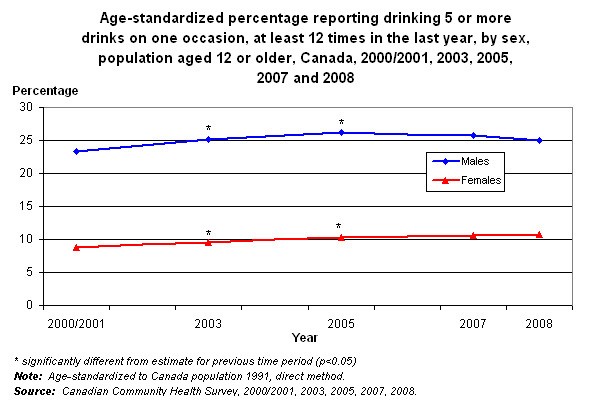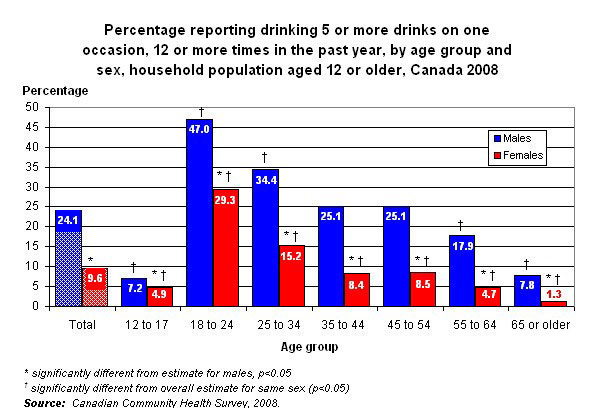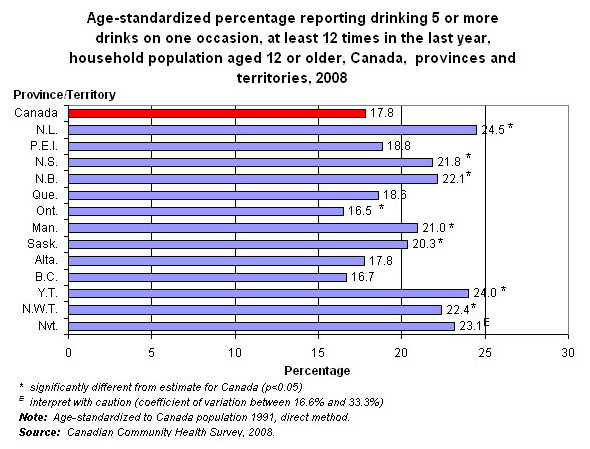Heavy drinking
Archived Content
Information identified as archived is provided for reference, research or recordkeeping purposes. It is not subject to the Government of Canada Web Standards and has not been altered or updated since it was archived. Please "contact us" to request a format other than those available.
Heavy drinking is defined as consuming 5 or more drinks on one occasion, 12 or more times over the past year. It is calculated for the population aged 12 or older.
Importance of Indicator
Heavy drinking has been associated with harmful health and social consequences, including increased risk of cardiovascular disease, hypertension, all-cause mortality, unintentional injuries, unprotected sex, drunk driving and illicit drug use1,2.
Background
Males are more likely than females to report heavy drinking, even when factors such as age, education, marital status and income are taken into account3.
Smoking has been associated with heavy drinking. In addition, having multiple chronic conditions and the presence of a smoker in the household increased the odds of heavy drinking4.
Binge drinking is more common than smoking among teenagers and young adults5.
Highlights and graphs
Time trend

- From 2000/2001 to 2008, age-standardized percentages of heavy drinking rose slightly.
- Males were about 2.5 times more likely than females to report having engaged in heavy drinking.
Note: Age–standardized, direct method to 1991 Canada population.
Age group and sex

- In 2008 an estimated 24.1% of males (3.3 million) and 9.6% of females (1.4 million) reported heavy drinking.
- In every age group, even among seniors, males were significantly more likely than females to have engaged in heavy drinking.
- Percentages of heavy drinking jump sharply at ages 18 to 24 (47.0% for males and 29.3% for females), compared with ages 12 to 17. This reflects the legal drinking age across Canada (18 or 19), as well a time of life when youth are more independent and may have moved out of the family home5.
- Among both sexes, people aged 18 to 34 were more likely than Canadians overall to engage in heavy drinking.
- Starting at age 35, percentages for females were below the overall percentage for Canada. For males, percentages of heavy drinking did not drop below the overall percentage until after age 54.
Province

- Age-standardized percentages of heavy drinking were significantly higher than the overall Canadian percentage in Newfoundland and Labrador, Nova Scotia, and New Brunswick.
- Percentages were also higher in Manitoba, Saskatchewan, Northwest Territories, and Yukon.
- Ontario was the only province or territory to report a significantly lower percentage of heavy drinking than did Canadians overall.
Note: Age–standardized, direct method to 1991 Canada population.
References
1. Yang S, Lynch JW, Raghunathan TE, et al. Socioeconomic and psychosocial exposures across the life course and binge drinking in adulthood: population-based study. American Journal of Epidemiology 2007; 165(2): 184-193.
2. Miller JW, Naimi TS, Brewer RD, Everett Jones S. Binge Drinking and Associated Health Risk Behaviors Among High School Students. Pediatrics 2007;119;76-85.
3. Adlaf EM, Ialomiteanu A, Rehm J. CAMH Monitor eReport: Addiction & mental health indicators among Ontario adults, 1977-2005 (CAMH Research Document Serios No. 24). 2008. Centre for Addiction & Mental Health, Toronto.
4. Pérez CE. Personal health practices: Smoking, drinking, physical activity and weight. Health Reports (Statistics Canada, Catalogue 82-003) 1999; 11(3): 83-90.
5. Galambos NL, Tilton-Weaver LC. Multiple-risk behaviour in adolescents and young adults. Health Reports (Statistics Canada, Catalogue 82-003) 1998; 10(2):9-20.
- Date modified:
